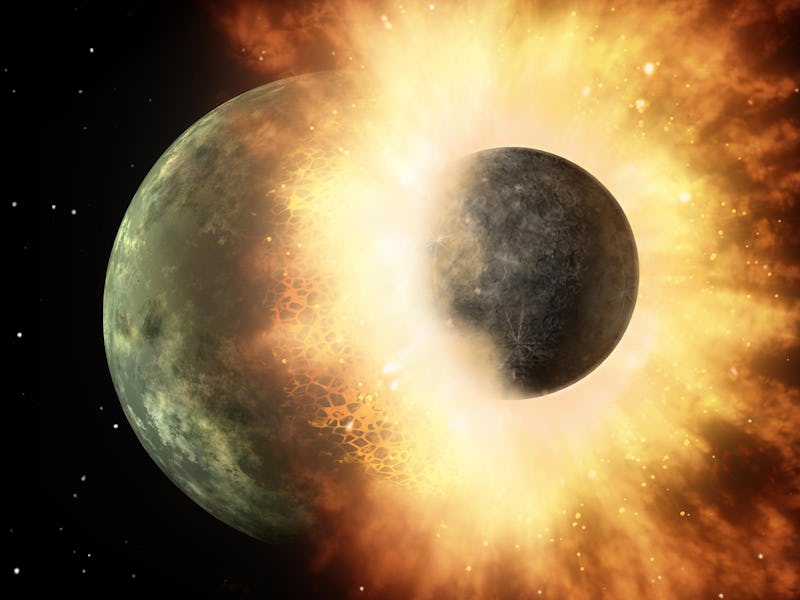An ancient protoplanet may be buried beneath the Pacific Ocean
Finally, scientists might be able to confirm how the Moon formed.

The aftermath of an ancient collision between Earth and a smaller protoplanet may be hidden deep within our planet’s mantle, according to a new theory.
The hypothesis comes from a team of scientists at Arizona State University, who together suggest the remains of an ancient protoplanet known as Theia may be found embedded in our own planet’s interior, buried in the deep layers of rock below West Africa and the Pacific Ocean.
The scientists presented their hypothesis at the 52nd Lunar and Planetary Science Conference held virtually between March 15-19. The theory will be laid out in a paper awaiting publication in the journal Geophysical Research Letters.
Why it matters — If this hypothesis is proven correct, then it provides the first direct evidence of the impact hypothesis that formed the Moon.
Qian Yuan, a Ph.D. candidate at the School of Earth and Space Exploration at Arizona State University and the lead author of the new paper, came up with the hypothesis during a planetary geochemistry class on the disputed origin story of the Earth’s Moon.
Scientists believe that sometime around 4 billion years ago, a massive object the size of Mars dubbed Theia collided with the young, developing Earth. The collision, so the theory goes, tossed vaporized particles from the Earth into space, bound together through gravity to form the Moon.
The early Solar System was a chaotic place.
This impact hypothesis remains unproven. It is one of three main theories of how the Moon formed. The other two suggest the Moon formed either at the same time as Earth in situ or that it was a wandering body captured by Earth's gravitational field.
“Although the Giant Impact hypothesis for Moon formation is widely accepted, scientists find it hard to provide direct evidence to suggest the existence of the hypothetic impactor Theia,” Yuan tells Inverse.
“This inspired me to think the missing Theia may go into the Earth after the impact.”
WHAT'S NEW — Yuan and his colleagues were intrigued by two large blobs within Earth’s mantle, which sit below West Africa and the Pacific Ocean. The planet’s core is wedged in between these blobs.
The blobs, formally known as large low-shear velocity provinces, were detected using seismic waves — these are the waves of energy that travel through Earth’s layers during an earthquake. As the waves passed through these blobs, they slowed down, suggesting to observing scientists that the blobs are much hotter and denser than the surrounding material.
Scientists are not sure why these provinces formed that way. But previous evidence suggests they have existed since the time the Moon formed, billions of years ago.
And according to the new hypothesis, these blobs may, in fact, be leftover remains of Theia.
HOW THEY DID IT — The scientists behind the new study created a young Earth model as it would have been 4.5 billion years ago and then simulated a collision with a Mars-sized object (Theia).
According to their model, most of Theia would have flung out into space upon colliding with the Earth. But fragments of Theia, like shrapnel from an exploding bomb, may have made their way into Earth’s mantle. Over billions of years, these fragments may have merged into our planet’s fabric, forming the two distinct blobs.
WHAT'S NEXT — The only way to prove the hypothesis is to extract samples from the large low-shear velocity provinces, which lie deep beneath Earth’s surface. Scientists would then need to compare those samples with the rock samples they have collected from the Moon. Some of these are more than 50 years old, brought back during NASA’s Apollo missions.
“If our hypothesis is right, there should be some chemical connection between the Moon and LLSVPs,” Yuan says.
“If the connection was established, it is highly likely the LLSVPs are the remnants of impactor Theia.”
Ultimately, collecting these samples means drilling deep into the surface below the Pacific Ocean — a difficult task made harder by the body of water — or under the ground in West Africa. But if scientists can build a robot that can drill for life on Mars, perhaps this endeavor may not be so far-fetched as we think.